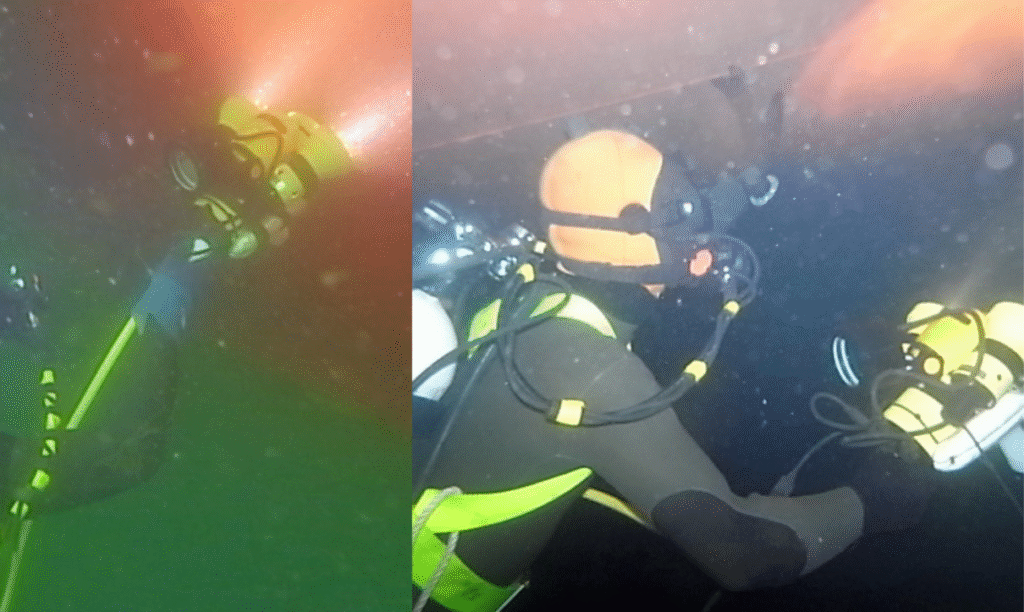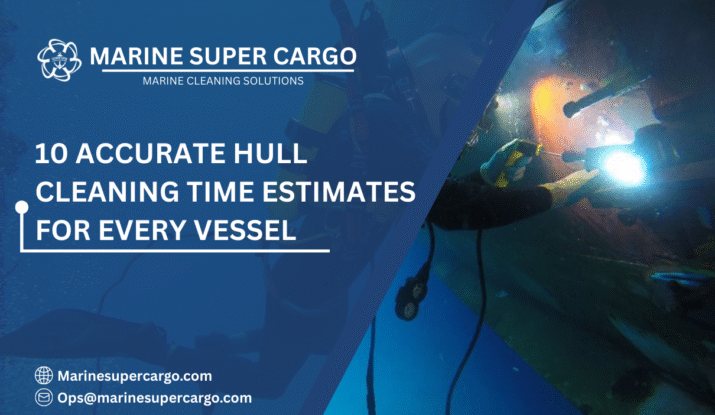Time is one of the most valuable currencies in shipping. For every hour a vessel lingers in port or anchorage, costs stack up like dominoes—crew wages, port dues, charter delays, and fuel inefficiencies. That’s why accurate Hull Cleaning Time Estimates are critical.
When it comes to underwater hull cleaning, the bigger the vessel, the more complex the challenge. But size isn’t the only factor. From fouling severity to environmental conditions, timelines can shift dramatically. In this guide, we’ll break down realistic time estimates across vessel categories—and explore how logistics, compliance, and innovation influence outcomes.
Whether you’re managing a fleet or a single vessel, this guide will help you plan smarter, save costs, and keep schedules on course.
Why Hull Cleaning Time Estimates Matter
Misjudging time for hull cleaning isn’t just an inconvenience—it can wreak havoc:
- Charter schedules are thrown off, incurring penalties.
- Increased fuel consumption if fouling isn’t managed.
- Crew overtime and inflated operational costs.
- Environmental violations if operations rush compliance steps.
Accurate Hull Cleaning Time Estimates are the difference between smooth sailing and costly delays. Think of them as the tide table of your operations—predictable, calculated, and essential.
Factors That Influence Time Estimates
Hull cleaning is rarely one-size-fits-all. Several elements can stretch or shorten the timeline:
- Vessel Size and Hull Area: Larger wetted surfaces mean longer cleaning.
- Level of Fouling: Light slime vs. heavy barnacle growth.
- Diver Experience & Crew Coordination: Skilled teams finish tasks faster.
- Tools Used: Hydraulic brushes, ROV assistance, or basic scrapers.
- Environmental Conditions: Currents, visibility, and water restrictions.
- Compliance Needs: Waste collection under the MARPOL Convention takes extra time.
- Location & Port Protocols: IAPH port rules and imo.org regulations dictate different standards.
By accounting for these, operators gain realistic Hull Cleaning Time Estimates instead of vague guesswork.

Hull Cleaning Time Estimates by Vessel Size
Here’s what cleaning typically looks like across categories. Note: these are averaged estimates assuming moderate fouling and an experienced crew with proper logistics.
Small Vessels (Yachts, Tugboats, Offshore Support)
- Time Estimate: 4–8 hours
- Why: Small surface area, simple designs, minimal fouling loads.
- Efficiency Tip: Often completed in a single dive shift.
Medium Vessels (Container Feeders, Ferries, Medium Tankers)
- Time Estimate: 12–24 hours
- Why: Larger hull areas, but still manageable with modern tools.
- Efficiency Tip: Deployed teams working bow-to-stern simultaneously cut duration.
Large Vessels (VLCCs, Bulk Carriers, Large Container Ships)
- Time Estimate: 36–60 hours
- Why: Massive wetted surface areas, deeper drafts, heavy fouling risk.
- Efficiency Tip: ROVs or hull-cleaning robots complement diver work, reducing delays.
Mega Vessels (ULCVs, LNG Carriers, Cruise Liners)
- Time Estimate: 72–96 hours or longer
- Why: Extremely large hulls with complex appendages (bilge keels, thrusters).
- Efficiency Tip: Divide into zones, stagger manpower rotations, and schedule cleaning alongside other port tasks.
These Hull Cleaning Time Estimates highlight how scaling directly impacts timelines.
🌊✨ Client Testimonial Spotlight ✨🌊
— Marine Super Cargo (@Marinsupercargo) September 16, 2025
💬 “The team at Marine Super Cargo feels like part of our crew. From hold cleaning to supercargo support, they handle everything seamlessly. Their quick response and reliable service saved us valuable time and money.” – Mr. Ingmar Domrös pic.twitter.com/bPlooKOakt
Pre-Cleaning Time Considerations
Before divers hit the water, there’s a prep element that adds hours to every job:
- Safety drills and crew briefings.
- PTW (Permit-to-Work) approvals and diving risk assessments (per IMCA guidelines).
- Communication system checks.
- Waste-collection systems setup.
Skipping this stage isn’t an option—it’s the meter that ensures the overall “clock” doesn’t hit pause due to mid-job surprises. Also read about underwater hull ceaning in Ausstrilia.
Logistics Impact on Time Estimates
Hull Cleaning Logistics—the manpower, tools, and consumables involved—can dramatically swing time.
- A fully prepared consumables stock shortens cleaning by avoiding resupply delays.
- Backup divers enable continuous operation without fatigue risks.
- Spare brushes, filters, and tools prevent breakdown-related downtime.
- Coordinating with port authorities early smooths compliance checks.
Well-designed logistics make Hull Cleaning Time Estimates not just accurate but dependable.
Compliance and Environmental Steps Add Time
Adhering to international frameworks ensures safety and sustainability, but it adds stages:
- MARPOL Convention requires the capture of all biofouling waste. Improper disposal can delay or halt cleaning completely.
- IMO Guidelines enforce safety practices, adding documentation before and after dives.
- Port-Specific Laws (IAPH): Some ports mandate additional inspections, extending schedules.
It’s better to plan an extra day into your estimate than to end up paying fines or failing audits.
Case Study: When Estimates Go Wrong
A bulk carrier’s operator assumed hull cleaning could be done in 24 hours. Heavy fouling tripled the expected time to 72 hours. Without staged manpower logistics, the divers were fatigued and work was paused twice. Result? Missed charter deadlines and $100,000 in losses.
Lesson: Hull Cleaning Time Estimates aren’t just numbers—they’re commitments with financial and safety weight.
Future of Time Estimation in Hull Cleaning
Technology is transforming how we generate reliable estimates:
- AI Predictive Models: Historical fouling and weather data generate ultra-accurate forecasts.
- ROVs and Hull Robots: Increasingly reducing divers’ time underwater.
- Digital Twin Hull Models: Compare before-and-after cleaning to benchmark times.
- Eco-Smart Cleaning Tools: Meet MARPOL requirements while working faster.
In the future, Hull Cleaning Time Estimates may be live, real-time projections instead of static planning figures.

Practical Guidance for Operators
- Always account for fouling variation beyond size alone.
- Build a 10–20% buffer into estimates for external delays.
- Engage certified teams with IMCA/IMO-compliant protocols.
- Plan heavily around waste disposal under MARPOL.
- Document all estimates, completions, and adjustments—it’ll refine accuracy fleet-wide.
Every accurate projection saves time, cost, and reputation.
Conclusion
Time is one of the most strategic resources in shipping. With accurate Hull Cleaning Time Estimates, operators can minimize downtime, control costs, and maintain compliance. The three key insights are:
- Vessel size, fouling level, and logistics all shape cleaning timelines.
- Compliance with MARPOL, IMO, and IMCA safeguards adds necessary time but prevents risk.
- Technology is making time estimates smarter, more predictive, and cost-saving.
For shipowners dedicated to safer, faster, and eco-friendly hull cleaning, expert support from CleanShip.co ensures operations stay on schedule and compliant.
FAQs:
Q1. Why are Hull Cleaning Time Estimates important?
They help operators budget time, labor, and costs while ensuring compliance, preventing financial losses from delays.
Q2. Do larger vessels always take longer to clean?
Yes—wetted surface area increases with vessel size, but fouling severity and equipment efficiency also influence time.
Q3. How does fouling affect time estimates?
Light slime may add only hours, while heavy barnacle growth can multiply cleaning timelines significantly.
Q4. Are regulators involved in hull cleaning durations?
Indirectly, MARPOL and IMO compliance steps extend time, as waste capture and logging are mandatory.
Q5. Can technology shorten hull cleaning times?
Yes—ROVs, AI prediction, and cleaning robots reduce dive time, optimize manpower, and streamline compliance processes.


